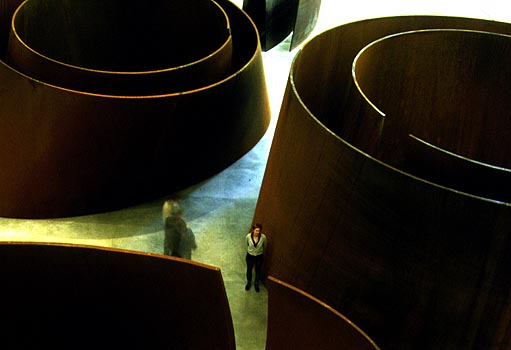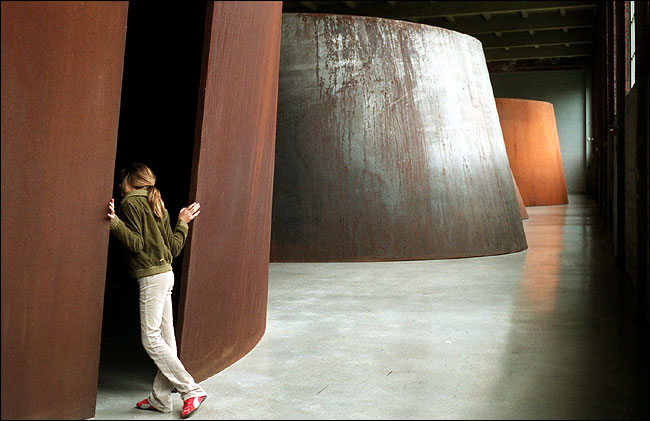Art 308: Sculpture Studio
Monica Milstead
Project 2- Kinetics and Interactivity
ARTIST RESEARCH
Bruce Nauman and Richard Serra both create environments that are interactive and engaging. But, at the same time, they dislocate the viewer from a normal spatial experience. Both of these artists set up very specific spatial parameters that the viewer is drawn into with different cues or lures. Once inside of the constructed spaces, the viewer must attempt to locate themselves comfortably or familiarly in these places.
Some of Bruce Nauman’s work has focused on accessing light as a sculptural tool. The element of light is such a useful tool because it is “both elusive and effervescent while aggressively pervading an environment.” Light is not a solid element, but it permeates its setting completely. When there is light in a setting, the eye automatically begins to contrast that with shadow. Light also introduces an aspect of interactivity—the viewer must cast a shadow at some point. And so, their body becomes an element in a sculptural environment because it changes the experience. Center to Nauman’s works with light is the viewer’s disorientation of light and space. In Nauman’s “Green Light Corridor,” (1970) the artist has constructed a corridor open at both ends that the viewer could pass all the way through. It is lit from within by an eerie green neon light. From the outside, the viewer approaches a corridor that emanates this green light. The viewer is lured in by the need or desire to discover the source of this light. Upon discovering an open corridor, it is an open invitation for the viewer to enter the space and walk down it. The walls begin to narrow further and further—causing some audience members to have to turn back rather than complete the exploration. The viewer’s perception of this space is the true subject matter—as Nauman has created an environment that is supposed to be encountered. The viewer’s body eventually presses up against Nauman’s claustrophobic passages, and alters their state of mind and body.
"Green Light Corridor" (1970)
Richard Serra similarly alters the viewer’s perceptions with his spatial constructs. While Nauman lures viewers in with his odd, emanating neon lights, Serra implements sheer size in order to pull the viewer in. In his series of “Torqued Ellipses,” Serra plays with the physical and mental encounters of spaces, and the tension between a spectator and his surroundings. Upon encountering these vast structures, the viewer approaches and walks around the structure, eventually finding an opening that they can enter into and begin to walk around inside of these spaces. For Richard Serra, what is important in these works is the body passing through space. A viewer’s movement must be determined by a “physical awareness in relation to space, place, time, and movement.” The torqued ellipses consist of tilting arcs of tall steel walls that at times lean over the viewer and at times fall away from the viewer. The space within and without these ellipses is constricted, at times the viewer must inch their ways between walls in order to reach the center.
Views of Serra's "Torqued Ellipses"Both Nauman and Serra make interactive works because they have created installations that pose spaces that the viewer physically can enter. Because of the size, the light, and other methods of invitation, the viewer desires to be inside of these spaces. That is the first step in interactivity. Once experiencing the structures though, there can be a variety of reaction: dependent upon the viewer. Some are comfortable in the spaces, some are disconcerted. Overall though, the artists alter the viewer’s state of mind with these curious spaces and strange physical encounters.
“Elusive Signs: Bruce Nauman Works with Light.” Milwaukee Art Museum Exhibition Reviews. http://mam.org/exhibitions/exhibition_details.aspx?ID=65
“Elusive Signs: Bruce Nauman Works with Light.”…
“Untitled Art should raise Question.” Nancy Spector. http://illegaloperation.multiply.com/links/item/2
“Richard Serra.” Lynne Cooke. http://www.diabeacon.org/exhibs_b/serra/essay.html
St. Mary's College of Maryland
St. Mary's City MD 20686-3001
Back to Index
This page was last updated: March 7, 2008 1:57 PM

